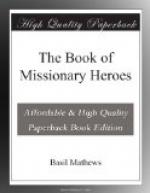Livingstone died in that hut (1873) and never knew what Stanley, following in his footsteps, discovered later (1876-7), viz., that the Luapula was really the upper stretch of the Congo, the second largest river in the world (3000 miles long), flowing into the Atlantic. The basin of the Congo would cover the whole of Europe from the Black Sea to the English Channel.
In the year when Livingstone died, and before Stanley started to explore the Congo, a young man, who had been thrilled by reading the travels of Livingstone, sailed to the West Coast of Africa to the Kameruns.
His name was George Grenfell, a Cornish boy (born at Sancreed, four miles from Penzance, in England), who was brought up in Birmingham. He was apprenticed at fifteen to a firm of hardware and machinery dealers. Here he picked up, as a lad, some knowledge of machinery that helped him later on the Congo. He had been thrilled to meet at Bristol College, where he was trained for his missionary work, a thin, worn, heroic man of tried steel, Alfred Saker, the great Kamerun missionary, and Grenfell leapt for joy to go out to the dangerous West Coast of Africa, where he worked hard, teaching the Africans to make tables and bricks and to print and read, healing them and preaching to them.
When Stanley came down the Congo to the sea and electrified the world by the story of the great river, Grenfell and the Baptist Missionary Society which he served conceived the daring and splendid plan of starting a chain of mission stations right from the mouth of the Congo eastward across Africa. In 1878 Grenfell was on his way up the river—travelling along narrow paths flanked by grass often fifteen feet high, and crossing swamps and rivers, till after thirteen attempts and in eighteen months he reached Stanley Pool, February 1881. A thousand miles of river lay between Stanley Pool and Stanley Falls, and even above Stanley Falls lay thirteen hundred miles of navigable river. Canoes were perilous. Hippopotami upset them, and men were dragged down and eaten by crocodiles. They must have a steamer right up there beyond the Falls in the very heart of Africa.
Grenfell went home to England, and the steamer Peace was built on the Thames, Grenfell watching everything being made from the crank to the funnel. She was built, launched, and tried on the Thames; then taken to pieces and packed in 800 packages, weighing 65 lbs. each, and taken to the mouth of the Congo. On the heads and shoulders of a thousand men the whole ship and the food of the party were carried past the rapids, over a thousand miles along narrow paths, in peril of snakes and leopards and enemy savages, over streams crossed by bridges of vine-creepers, through swamps, across ravines.
Grenfell’s engineer, who was to have put the ship together, died. At last they reached Stanley Pool. Grenfell with eight negroes started to try to build the ship. It was a tremendous task. Grenfell said the Peace was “prayed together.” It was prayer and hard work and gumption. At last the ship was launched, steam was up, the Peace began to move. “She lives, master, she lives!” shouted the excited Africans.




